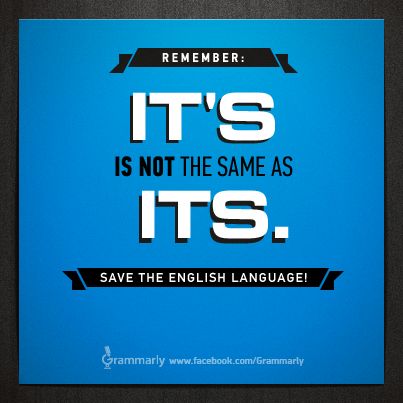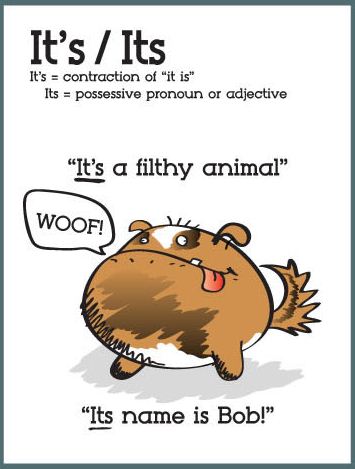What are your pet grammar peeves? Which grammar mistakes set your teeth on edge?
Is it the misuse of apostrophes for plurals?
Perhaps the incorrect your/you’re or their/there/they’re?
Maybe it’s dangling modifiers or stray semicolons that get your goat.
Top of my list has to be when people mix up it’s with its. NB: This is only an issue in written English as when spoken they both sound the same.
It’s a common error
 This seems to be a regular occurrence, whether it’s in text messages, emails, social media posts, website content, signage or in print.
This seems to be a regular occurrence, whether it’s in text messages, emails, social media posts, website content, signage or in print.
I grant that sometimes the wrong selection of it’s or its is a genuine typo, due to autocorrect interference or simply rushed typing. But, more often than not, it’s a grammar mistake due to not understanding the relevant rule.
A recent online magazine proofreading job really brought the issue home. I ended up spending far more time than anticipated due to having to annotate each incorrect use of its or it’s on an 80-page PDF. Fun it was not!
So, this got me thinking that others might appreciate a quick explanation of how to know whether to use it’s or its. In particular, it must be confusing for anyone learning English as a second language to understand the difference.
Without further ado, I present you it’s vs. its.

It’s
It’s is a contraction of the words it + is or it + has. The apostrophe is used to show that one or more letters have been removed.
This the ONLY meaning of it’s.
E.g. It’s cold today = It is cold today.
E.g. Oh look, it’s started snowing = Oh look, it has started snowing.
Both versions are correct English, but we tend to use the shortened form in speech and informal writing because it sounds more natural and fluent.
Its
Its is the possessive form of the neuter pronoun it, meaning that something belongs to it or is of it.
E.g. The cat meowed because its bowl was empty.
E.g. Stratford-upon-Avon is best known for its links with Shakespeare.
So what’s the problem?
 This all seems straightforward enough. But the confusion is caused by the fact that in English we usually use ’s to indicate possession, e.g. The dog’s legs were tired (instead of The dogs legs were tired).
This all seems straightforward enough. But the confusion is caused by the fact that in English we usually use ’s to indicate possession, e.g. The dog’s legs were tired (instead of The dogs legs were tired).
Because this grammar rule was drummed into us at school, a lot of people assume that the possessive form of its requires an apostrophe.
It doesn’t.
In fact, think of it as being similar to other possessive personal pronouns such as his, hers, ours, yours and theirs – none of which take an apostrophe. The only exception to this is one, as in the title of Virginia Woolf’s novel “A Room of One’s Own”.
Wind back a few centuries…
But, as Merriam Webster informs us, it was a different matter a few centuries ago.
The apostrophe form of the possessive – it’s – began to be used around 1600 and remained extremely common throughout the 17th century. The apostrophe-less version only became dominant in the 18th century, probably because it’s was taking on a new role to replace the former contraction ’tis.
Still unsure if it should be it’s or its?
For those of you who find mnemonic devices useful, just remember: It’s an apostrophe.
If you’re still not sure which version to use, the best advice is to try replacing the word with it is or it has. If neither of these fits the sentence, then you need its without the apostrophe. No exceptions.
E.g. The cat meowed because it is/it has bowl was empty doesn’t make sense.
Another top tip is to try replacing its with another pronoun, such as his, her or their. If one of these makes sense grammar-wise (even if it sounds a bit odd), then you want its without the apostrophe.
E.g. The cat meowed because her bowl was empty.
And finally, just in case you were wondering, its’ is never – ever – correct. So just don’t go there.
Have your say